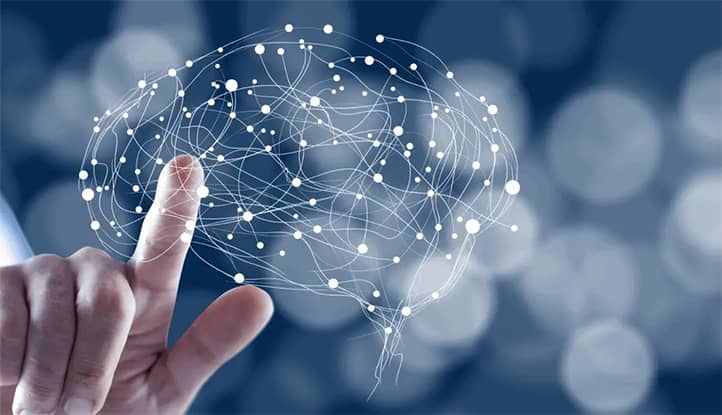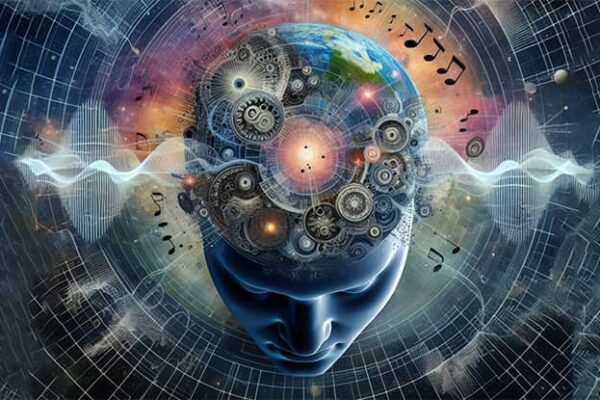Neurobiology is a fascinating science that explores the structure and function of the brain, uncovering the mysteries of how this complex organ governs our lives. Weighing only about 1.5 kilograms, the brain serves as the command center for everything we do, feel, and think. It not only controls our movements and speech but also emotions, memory, decision-making, and even our dreams.
Neurobiology helps us understand how billions of neurons interact to create our consciousness and personality. This science lies at the intersection of biology, psychology, medicine, and even philosophy, making it one of the most interdisciplinary and promising fields of knowledge.
Why is studying the brain so important? The answer is simple: the brain is what makes us human. Thanks to it, we can love, create, learn, and adapt to changing conditions.
Neurobiology not only explains how the brain functions under normal conditions but also helps us understand the causes of many diseases, such as Alzheimer’s disease, depression, and epilepsy. Moreover, it provides insights into improving quality of life, enhancing productivity, and even understanding ourselves better.
The brain can be compared to a conductor leading a vast orchestra, where each instrument represents a different function of the body. It coordinates all systems, from breathing and heartbeat to complex cognitive processes such as analyzing information or planning.
But how exactly does this happen? How can the brain, composed of water, fats, and proteins, generate thoughts, emotions, and creative ideas? These questions have long remained a mystery, but thanks to neurobiology, we are gradually finding answers.
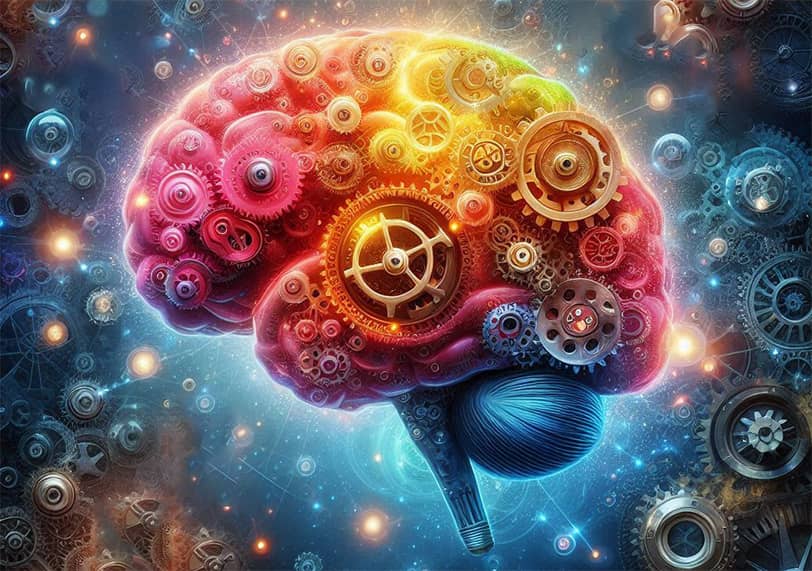
Structure and Functions of the Brain
The brain is an incredibly complex organ consisting of many interconnected regions, each with its own unique functions. To understand how the brain governs our lives, it is essential to examine its structure and how its different parts interact. The brain can be divided into three main areas: the cerebral cortex, the limbic system, and the brainstem. Each of these regions is responsible for different aspects of our existence, from basic instincts to higher cognitive processes like thinking and creativity.
But how do these regions work together to enable us to move, feel, think, and make decisions? To answer this question, let’s take a closer look at the structure and functions of each region and how they interact to perform everyday tasks.
A Brief Overview of Brain Structure
The human brain consists of several key regions, each playing a crucial role in sustaining life.
- Cerebral cortex – the outer layer of the brain responsible for higher cognitive functions such as thinking, speech, memory, and consciousness. The cortex is divided into four lobes: frontal, parietal, temporal, and occipital. For example, the frontal lobe is responsible for decision-making and planning, while the occipital lobe processes visual information.
- Limbic system – located deeper within the cortex, it includes structures such as the hippocampus, amygdala, and hypothalamus. This system plays a key role in emotions, memory, and motivation. For instance, the amygdala processes fear and other emotions, while the hippocampus is essential for forming long-term memories.
- Brainstem – the most ancient part of the brain, connecting it to the spinal cord. It regulates basic functions such as breathing, heartbeat, and sleep. The brainstem also plays a vital role in transmitting signals between the brain and the rest of the body.
Key Functions of Brain Regions: Thinking, Emotions, Instincts
Each part of the brain has unique functions, yet they all work together in a highly coordinated manner.
- Cerebral cortex is responsible for higher cognitive functions, such as thinking, speech, and consciousness. Thanks to the cortex, we can analyze information, solve complex problems, and plan for the future. For example, as you read this article, your cortex is processing the text, analyzing its meaning, and storing key details in memory.
- Limbic system plays a crucial role in forming emotions and motivation. Feelings of joy or fear are the result of the amygdala and other structures within the limbic system. The hippocampus, on the other hand, helps store important experiences and events, allowing you to learn from both mistakes and successes.
- Brainstem is responsible for fundamental survival functions such as breathing, heartbeat, and sleep regulation. It also controls reflexes like blinking or reacting to pain. For example, if you accidentally touch a hot surface, your brainstem instantly sends a signal to your muscles to withdraw your hand before you even consciously register the pain.
How Does the Brain Control Body Movements?
To understand how the brain controls movements, let’s consider a simple example: raising your hand to wave at a friend. This process begins in the frontal lobe of the cerebral cortex, where the intention is formed and the decision is made. The signal is then transmitted to the motor cortex, which plans and initiates the movement.
From the motor cortex, the signal travels to the brainstem and then down the spinal cord, where it is relayed to motor neurons controlling the arm muscles. Simultaneously, the cerebellum, responsible for coordination, ensures the movement is smooth and precise.
This entire process takes only fractions of a second and happens automatically, without requiring conscious control. This is just one example of how the brain manages our movements, ensuring precision and coordination.
Thus, the structure and functions of the brain form a complex yet incredibly harmonious system that allows us to interact with the world, feel, think, and act. Understanding how the brain works helps us find ways to improve our quality of life, whether through learning, emotional management, or maintaining our health.
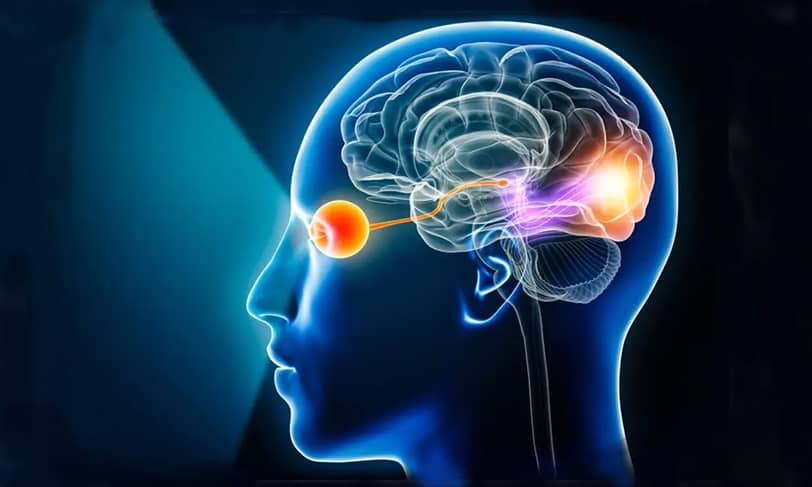
The Brain and Everyday Life
The brain is not only an organ that governs our thoughts and emotions but also a complex system that processes a vast amount of information from the external world every second. Every day, we encounter numerous stimuli—sounds, light, smells, and touches—all of which are perceived by our sensory organs and transmitted to the brain for processing. But how exactly does the brain manage this flow of data? How does it turn light into images, sound waves into words, and touch into sensations?
To answer these questions, it is important to understand how neurons work—the fundamental cells of the brain that transmit information through electrical and chemical signals. Neurons are connected by synapses, which play a key role in passing information from one cell to another. Thanks to this intricate network, we can perceive and respond to the world around us.
In daily life, we often do not think about how the brain controls our reactions. For example, why do we instinctively turn our heads toward a loud sound or squint in bright light? These processes seem natural to us, but they are actually governed by complex mechanisms within the brain.
How Does the Brain Process Information from the External World?
The brain receives information from the outside world through the sensory organs: eyes, ears, skin, nose, and tongue. Each of these organs transmits data to specific areas of the brain, where the information is processed and interpreted. For example, light reaches the retina of the eye, where specialized cells convert it into electrical signals. These signals are transmitted via the optic nerve to the occipital lobe of the brain, where image processing occurs.
Similarly, sound waves are captured by the ear and converted into electrical signals in the inner ear. These signals travel to the temporal lobe of the cortex, where the brain recognizes sounds and interprets them as speech, music, or noise.
It is important to note that the brain does not simply passively receive information but also actively filters it. For instance, out of the vast stream of visual data, it highlights the most important details, such as movement or familiar faces. This allows us to focus on what truly matters while ignoring unnecessary details.
The Role of Neurons and Synapses in Signal Transmission
Neurons are the primary cells of the brain responsible for transmitting information. Each neuron consists of a cell body, dendrites (which receive signals), and an axon (which transmits signals to other neurons). When a neuron is activated, it generates an electrical impulse that travels along the axon and reaches the synapse—the junction between neurons.
Synapses play a crucial role in information transfer. When an electrical impulse reaches the end of an axon, it triggers the release of chemicals called neurotransmitters. These substances cross the synaptic gap and bind to receptors on the dendrites of the next neuron, leading to the generation of a new electrical impulse.
This process of signal transmission happens at incredible speed, allowing the brain to quickly process information and respond to environmental changes. For example, when you hear a loud sound, signals from the ear reach the brain within milliseconds, enabling you to turn your head toward the source of the sound almost instantly.
Why Do We React to Sound or Light?
To understand how the brain controls our reactions, let’s look at an example of responding to sound or light. Imagine you are in a quiet room, and suddenly, there is a loud bang. Sound waves reach your ear, where they are converted into electrical signals. These signals travel via the auditory nerve to the temporal lobe of the cerebral cortex, where sound recognition takes place.
At the same time, the amygdala, which is responsible for processing emotions like fear, is activated. The amygdala sends a signal to the hypothalamus, which activates the sympathetic nervous system, triggering the “fight or flight” response. As a result, your heart starts beating faster, your muscles tense, and you instinctively turn your head toward the sound.
A similar process occurs when you see a bright light. Light hits the retina, where it is converted into electrical signals that are transmitted to the occipital lobe of the cortex. The brain recognizes bright light as a potentially hazardous stimulus, prompting you to squint or close your eyes to protect them.
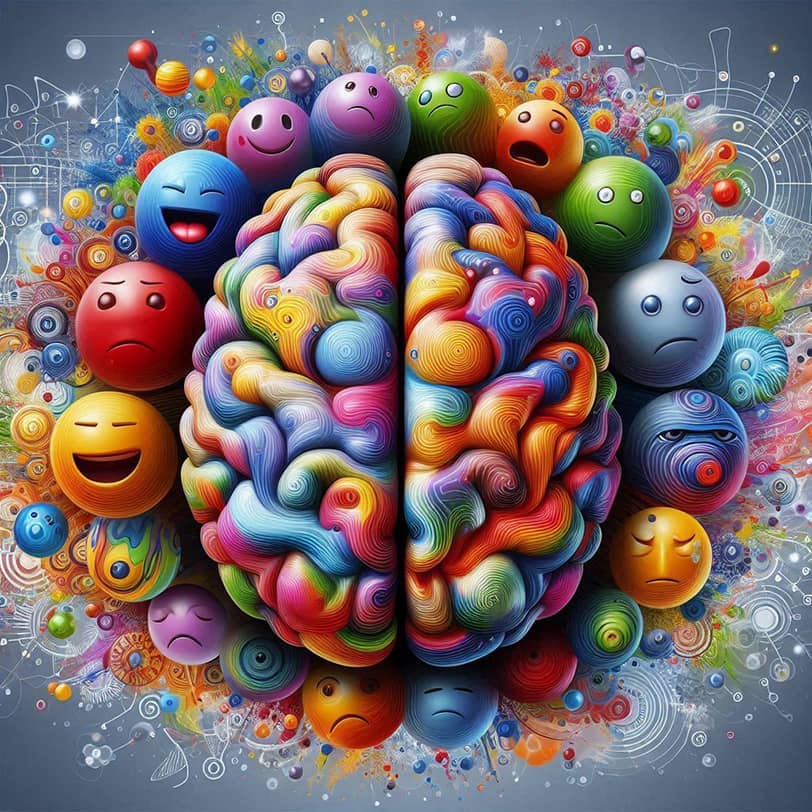
The Brain and Emotions
Emotions are an integral part of our lives. They color our experiences, influence decision-making, and help us interact with the world around us. But what lies behind our emotions? How does the brain create feelings of joy, fear, anger, or sadness? The answers to these questions are found in the field of neurobiology, which studies how different brain structures interact to generate emotional responses.
Emotions are not just abstract experiences but complex physiological processes that begin in the brain and affect the entire body. For example, when we feel fear, our brain activates a cascade of reactions that prepare the body for action: our heart rate increases, muscles tense, and attention becomes more focused. These processes are controlled by structures such as the amygdala and the prefrontal cortex, which play key roles in the formation and regulation of emotions.
But why do the same situations evoke different emotions in different people? Why does one person feel joy while another feels anger? And how does stress, an unavoidable part of modern life, affect the brain and body? To answer these questions, let’s take a closer look at how the brain creates emotions, what mechanisms underlie our feelings, and how stress can alter brain function.
How Does the Brain Create Emotions?
Emotions arise from the complex interaction of different brain regions, but two key structures play a central role in this process: the amygdala and the prefrontal cortex.
- The amygdala is a small structure in the limbic system responsible for processing emotions, especially fear and anxiety. When we encounter a potentially dangerous situation, the amygdala is instantly activated, triggering the “fight or flight” response. It sends signals to the hypothalamus, which then activates the sympathetic nervous system, leading to physiological changes such as increased heart rate and the release of adrenaline.
- The prefrontal cortex, located in the frontal lobe of the brain, acts as a “regulator” of emotions. It helps us evaluate situations, control impulsive reactions, and make rational decisions. For example, if you feel anger, the prefrontal cortex can “calm down” the amygdala, helping you maintain self-control.
Interestingly, the balance between amygdala and prefrontal cortex activity determines how intensely we experience emotions. People with a highly active amygdala and a weaker prefrontal cortex may have stronger emotional reactions, making them more prone to anxiety or aggression.
Why Do We Feel Joy, Fear, Anger, or Sadness?
Emotions are the result of a complex interplay of neurons, neurotransmitters, and hormones. Each emotion has its own unique “chemical signature”:
- Joy is often associated with increased levels of dopamine and serotonin—neurotransmitters responsible for feelings of pleasure and satisfaction. When we achieve a goal or receive a reward, the brain releases dopamine, creating a sense of joy and motivation.
- Fear and anxiety are linked to amygdala activity and the release of stress hormones such as cortisol and adrenaline. These hormones prepare the body for action by increasing heart rate and muscle tension.
- Anger also involves the amygdala, but in this case, norepinephrine (noradrenaline) plays a key role, increasing arousal and aggression.
- Sadness is often associated with low levels of serotonin and dopamine. For example, in depression, the activity of these neurotransmitters decreases, leading to feelings of hopelessness and apathy.
How Does Stress Affect the Brain and Body?
Stress is a natural reaction to threats or challenges, but chronic stress can have serious consequences. When we face a stressful situation, the amygdala becomes activated and sends signals to the hypothalamus, which triggers the release of cortisol—the primary stress hormone.
Short-term stress can be beneficial, as it mobilizes the body’s resources and improves focus. However, chronic stress leads to a constant increase in cortisol levels, which negatively affects the brain. For example, high cortisol levels can damage the hippocampus—the brain region responsible for memory and learning. This can result in cognitive decline and an increased risk of depression.
Additionally, chronic stress weakens the prefrontal cortex, reducing its ability to regulate emotions. This can lead to heightened anxiety, irritability, and impulsivity.
Example: Imagine you are working on a complex project with tight deadlines. The constant pressure and fear of failure create chronic stress. Over time, you may notice that you become more forgetful, struggle to focus, and feel more irritable. This is a result of prolonged cortisol exposure affecting your brain.
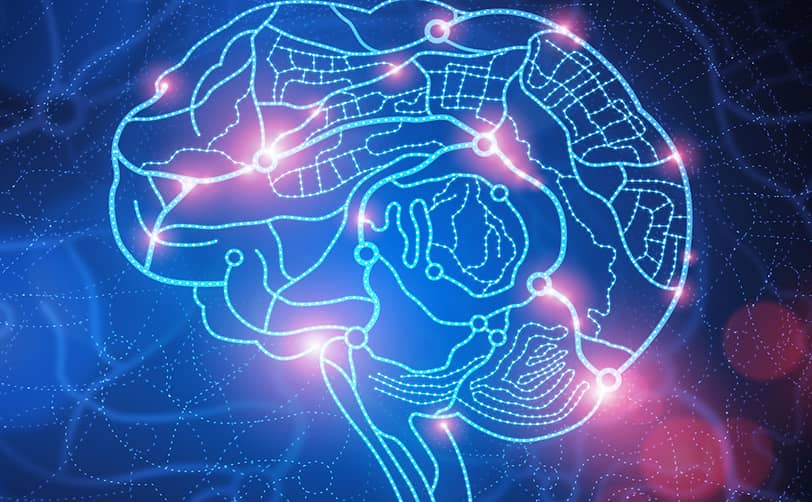
The Brain and Decision-Making
Decision-making is a process that accompanies us daily, from choosing what to wear in the morning to complex life decisions such as selecting a career or a partner. But how does the brain handle this task? How does it weigh options, assess risks, and choose the optimal path?
Decision-making is a complex cognitive process involving various brain regions, including the prefrontal cortex, the limbic system, and the reward system. Each time we face a choice, the brain analyzes available information, evaluates possible consequences, considers our emotions, and draws on past experiences.
However, this process does not always occur consciously. Sometimes, we act impulsively, influenced by momentary desires or emotions. Why does this happen? And what role does dopamine—the neurotransmitter often called the “pleasure hormone”—play in this process?
To answer these questions, let’s take a closer look at how the brain makes decisions, the role of the reward system in this process, and why we sometimes act against our long-term interests. Understanding these mechanisms can help us better manage our decisions and avoid impulsive actions.
How Does the Brain Weigh Options and Make Choices?
Decision-making begins with evaluating available options. When faced with a choice, the prefrontal cortex—the brain region responsible for planning and logical thinking—activates to analyze information. It assesses the pros and cons of each option, considering potential consequences and risks.
At the same time, the limbic system, which governs emotions, also plays a role in the process. Emotions are crucial in decision-making because they help us quickly assess situations based on past experiences. For example, if you previously had a negative experience in a similar situation, the limbic system might “warn” you to avoid making the same choice.
Additionally, the anterior cingulate cortex (part of the prefrontal cortex) helps resolve conflicts between different options. For instance, if you’re choosing between a healthy but bland meal and a tasty but unhealthy one, the anterior cingulate cortex helps weigh short-term pleasures against long-term consequences.
The Role of Dopamine in the Reward System
Dopamine is a neurotransmitter that plays a key role in the brain’s reward system. It is released when we receive something pleasurable or beneficial, such as delicious food, praise, or financial rewards. Dopamine not only creates a sense of pleasure but also motivates us to repeat actions that led to that reward.
The reward system is closely linked to decision-making. When we consider different options, the brain evaluates how much pleasure or benefit each one might bring. If one option promises a greater dopamine reward, the brain tends to favor it. For example, if you must choose between work and relaxation, the brain may “push” you toward relaxation because it promises immediate gratification.
Why Do We Sometimes Act Impulsively?
Impulsive behavior results from a conflict between the prefrontal cortex, which governs rational thinking, and the limbic system, which is linked to emotions and desires. When we encounter temptation, the limbic system activates, triggering a dopamine release and creating a strong desire for immediate gratification.
Example: Imagine you’ve decided to give up sweets, but then you see a tempting piece of cake on the table. Your prefrontal cortex reminds you of your diet and long-term goals, but your limbic system, reinforced by dopamine, insists on immediate pleasure. If the limbic system overpowers the prefrontal cortex, you might eat the cake despite knowing it contradicts your plans.
Impulsive behavior can also be linked to low prefrontal cortex activity. For instance, individuals with attention deficit hyperactivity disorder (ADHD) have a less active prefrontal cortex, making them more prone to impulsive actions.
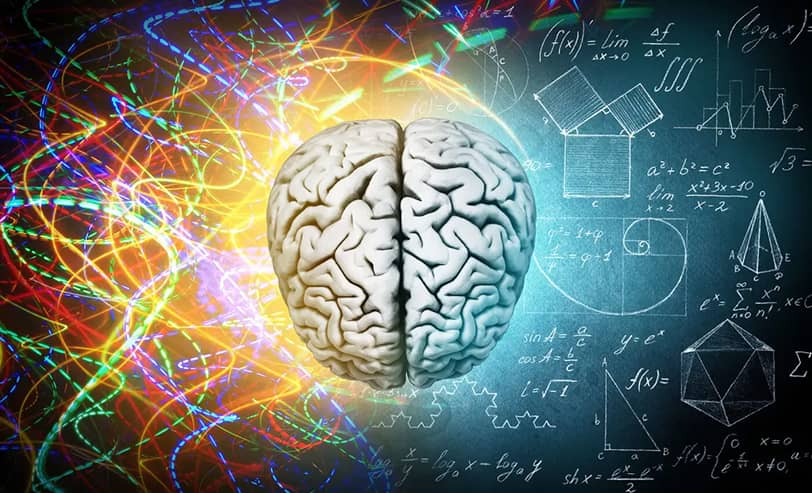
The Brain and Learning
Learning is a fundamental process that enables us to adapt to changing conditions, acquire new skills, and accumulate knowledge. But how exactly does the brain learn? What happens in its structures when we memorize information, master new abilities, or form habits? The answers to these questions lie at the core of neurobiology, which studies the brain’s ability to change—neuroplasticity.
Neuroplasticity is the brain’s remarkable ability to reorganize itself in response to new experiences. Thanks to this, we can learn throughout our lives, form new neural connections, and even recover lost functions after injuries. One of the key structures responsible for learning and memory is the hippocampus. It plays a crucial role in converting short-term memory into long-term memory, allowing us to retain important information for years.
However, learning is not just about memorizing facts. It also involves forming habits, which become automatic due to changes in the brain’s structure. For example, when learning to drive a car, it initially requires immense concentration, but over time, the actions become automatic. How does this happen? Let’s take a closer look at how the brain adapts and how habits reshape its structure.
Neuroplasticity: How the Brain Adapts and Learns
Neuroplasticity is the brain’s ability to change its structure and function in response to new experiences, learning, or injuries. This property is at the core of our ability to learn and adapt. When we acquire a new skill, such as playing the guitar or learning a foreign language, physical changes occur in the brain: new neural connections form, and existing ones become stronger.
Neuroplasticity is made possible by two primary processes: synaptic plasticity and neurogenesis.
- Synaptic plasticity refers to the ability of synapses (connections between neurons) to change their strength depending on activity. For example, if you repeatedly practice a new word, the synapses associated with its memory become stronger, allowing the word to transition into long-term memory.
- Neurogenesis is the process of generating new neurons, primarily occurring in the hippocampus. While it was once believed that neurons could not regenerate, modern research has shown that the brain can create new cells even in adulthood. This is especially important for learning and memory.
The Role of the Hippocampus in Memory Formation
The hippocampus is a small structure in the limbic system that plays a key role in forming and consolidating memory. It is responsible for converting short-term memory into long-term memory, enabling us to retain information for extended periods.
When we receive new information, it is first processed in the cerebral cortex and then transferred to the hippocampus. Here, the information is sorted and linked to existing knowledge. If the information is deemed important, the hippocampus strengthens neural connections, moving it into long-term memory.
Interestingly, the hippocampus also plays a role in spatial memory. For example, it helps us remember routes and navigate our surroundings. Studies have shown that London taxi drivers, who must memorize complex routes, have a larger hippocampus than the average person.
How Do Habits Change the Brain’s Structure?
Habits are automatic actions that we perform without conscious effort. They form due to neuroplasticity, which allows the brain to optimize frequently repeated actions. When we first perform a new action, such as brushing our teeth or tying our shoelaces, it requires active involvement from the prefrontal cortex, which is responsible for conscious control.
However, as the action is repeated many times, it becomes stored in the basal ganglia—brain structures responsible for automatic behaviors. This occurs due to the strengthening of neural connections related to the action. For example, when learning to tie shoelaces, you initially need to consciously control each movement, but over time, the action becomes automatic.
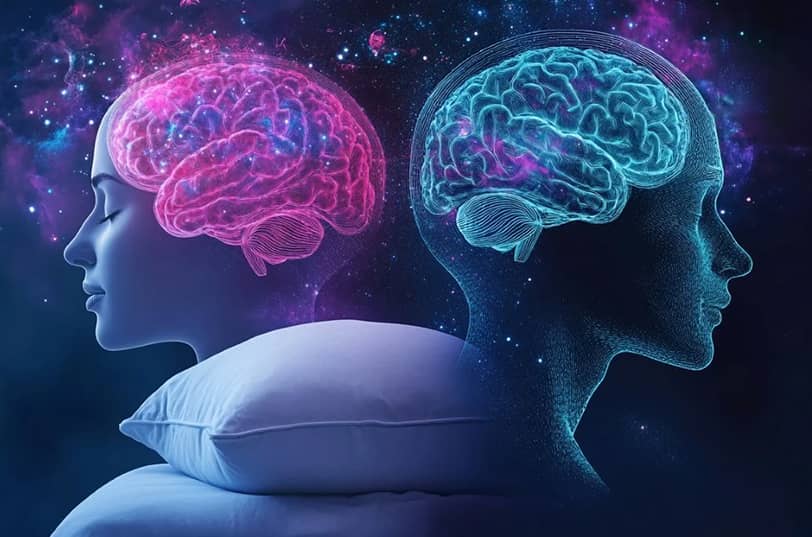
The Brain and Sleep
Sleep is not just a period of rest but a crucial biological process that plays a key role in brain function and overall health. During sleep, the brain does not shut down; instead, it actively performs numerous functions necessary for maintaining cognitive abilities and well-being. But why is sleep so important? What exactly happens in the brain while we sleep? And how does sleep deprivation affect our thinking, emotions, and behavior?
Modern research shows that sleep is a time when the brain “resets,” clears out toxins, processes the information gathered during the day, and strengthens memory. Without sufficient sleep, the brain cannot function efficiently, leading to impaired concentration, memory, and emotional stability. But how exactly does the brain recover during sleep? And what happens when we chronically lack sleep?
Why Is Sleep Essential for Brain Function?
Sleep is necessary for maintaining brain health and cognitive functions. During sleep, the brain performs several key tasks that are impossible during wakefulness.
- Memory Consolidation – Throughout the day, we receive vast amounts of information, and during sleep, the brain sorts and stores essential data, transferring it from short-term to long-term memory.
- Brain Detoxification – Sleep plays a crucial role in clearing toxins from the brain. During wakefulness, metabolic waste products, such as beta-amyloid proteins (linked to neurodegenerative diseases like Alzheimer’s), accumulate. During sleep, the glymphatic system becomes active, flushing out these toxins.
- Energy Restoration – While awake, neurons actively work, consuming energy. During sleep, they recover, allowing the brain to function efficiently the next day.
How Does the Brain “Reset” During Sleep?
Sleep consists of several stages, each serving distinct functions. These stages are divided into two primary phases: Non-REM (slow-wave sleep) and REM (rapid eye movement) sleep.
- Non-REM Sleep includes three stages, during which the brain gradually transitions from light to deep sleep. During this phase, the body and brain undergo restoration: heart rate slows, muscles relax, and toxins are cleared. Deep sleep is particularly important for memory consolidation and energy recovery.
- REM Sleep is the phase during which we experience dreams. In this stage, the brain is almost as active as it is during wakefulness, but the body remains paralyzed (except for the eyes and breathing muscles). REM sleep plays a crucial role in processing emotions and reinforcing skills learned during the day.
During sleep, the brain also “resets” neural networks, removing unnecessary connections and strengthening important ones. This helps improve cognitive functions such as attention, memory, and learning ability.
What Happens to the Brain During Sleep Deprivation?
Chronic sleep deprivation has a severe impact on brain function. When we do not get enough sleep, the brain fails to complete essential processes such as toxin clearance, memory consolidation, and energy restoration. This results in cognitive impairment and emotional instability.
Example: Imagine you have slept less than six hours for several nights in a row. As a result, you may notice that you become more distracted, struggle to remember information, and react more slowly to changes. This happens because sleep deprivation reduces activity in the prefrontal cortex, which is responsible for attention, planning, and decision-making.
Additionally, lack of sleep increases amygdala activity, making us more emotionally reactive. For instance, you may find yourself feeling more irritable or anxious. This occurs because the brain has not had enough time to process the emotions accumulated throughout the day.
Chronic sleep deprivation also increases the risk of developing neurodegenerative diseases, such as Alzheimer’s disease. This is because, without sufficient sleep, toxic proteins like beta-amyloid build up in the brain, potentially damaging neurons over time.
Understanding the role of sleep in brain function highlights its importance for mental clarity, emotional well-being, and overall health. Prioritizing quality sleep can significantly improve cognitive performance and long-term brain health.
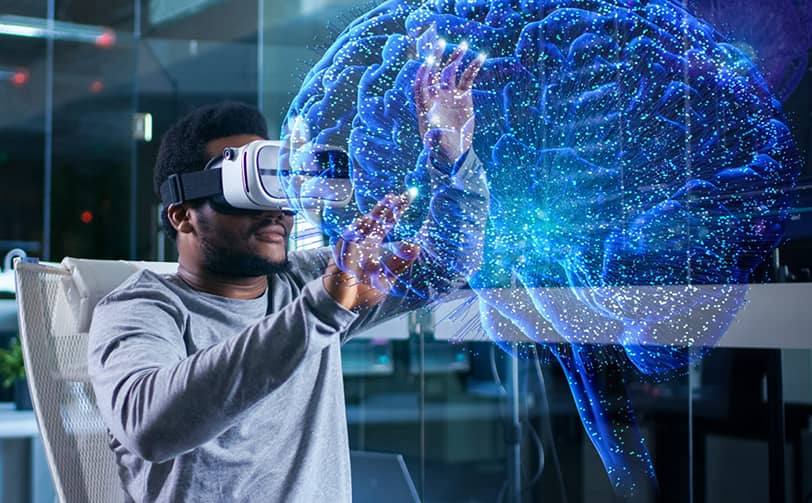
Practical Applications of Neurobiology
Neurobiology is not just a fundamental science that studies the structure and function of the brain; it is also a field of knowledge with immense practical significance. Understanding how the brain works allows us to develop new treatments for diseases and optimize everyday life. From medicine to education and personal development, neurobiology provides tools that help us take better care of our brains and maximize their potential.
Neurobiology in Medicine
Neurobiology plays a key role in developing new treatments for neurodegenerative diseases such as Alzheimer’s and Parkinson’s. These diseases are associated with the gradual death of neurons, leading to a decline in cognitive and motor functions.
- Alzheimer’s disease is characterized by the accumulation of toxic proteins in the brain, such as beta-amyloid and tau protein. Neuroscientists study the mechanisms that lead to their formation and develop drugs that can slow down or stop this process. For example, modern research focuses on creating antibodies that bind to and remove beta-amyloid from the brain.
- Parkinson’s disease is caused by the death of dopamine-producing neurons, which leads to impaired motor functions. Neurobiology helps develop treatment methods such as deep brain stimulation (DBS), which can reduce symptoms. Additionally, research is being conducted on the use of stem cells to restore lost neurons.
Neurobiology also aids in the treatment of mental disorders such as depression and anxiety disorders. Understanding the role of neurotransmitters like serotonin and dopamine allows for the development of more effective antidepressants and therapeutic approaches.
Neurobiology in Education
Neurobiology offers new approaches to learning based on an understanding of how the brain processes and retains information. These insights help create more effective teaching methods tailored to individual learning styles.
- Active learning: Research shows that the brain retains information better when it is linked to active engagement. Discussions, problem-solving, and practical applications help strengthen neural connections.
- Multitasking and attention: Neurobiology has proven that multitasking reduces learning efficiency. Instead, focusing on a single task allows the brain to process information more deeply.
- The role of emotions in learning: Emotions play a crucial role in memory retention. Positive emotions, such as interest and enthusiasm, enhance motivation and improve knowledge absorption. This is why modern educational methods incorporate gamification and interactive learning elements.
- Repetition and spaced learning: Neurobiology confirms that revisiting material at specific intervals (spaced repetition) helps strengthen long-term memory.
Neurobiology in Everyday Life
Neurobiology provides simple yet effective recommendations for improving brain function and maintaining cognitive health.
- 🧠 Sleep: Quality sleep is essential for brain recovery, memory consolidation, and toxin removal. It is recommended to sleep 7–9 hours per night and maintain a consistent sleep schedule.
- 🥦 Nutrition: The brain requires nutrients such as omega-3 fatty acids, antioxidants, and B vitamins. Include fish, nuts, berries, leafy greens, and whole grains in your diet.
- 🏃 Physical activity: Regular exercise improves brain circulation, stimulates neurogenesis, and increases levels of neurotrophic factors like BDNF, which promote neuron growth.
- 🎭 Mental activity: Engaging in tasks that require concentration and creativity (e.g., learning a new language or playing a musical instrument) helps maintain cognitive function.
- 🧘 Stress management: Chronic stress negatively affects the brain, so it is important to use relaxation techniques such as meditation, breathing exercises, or yoga.
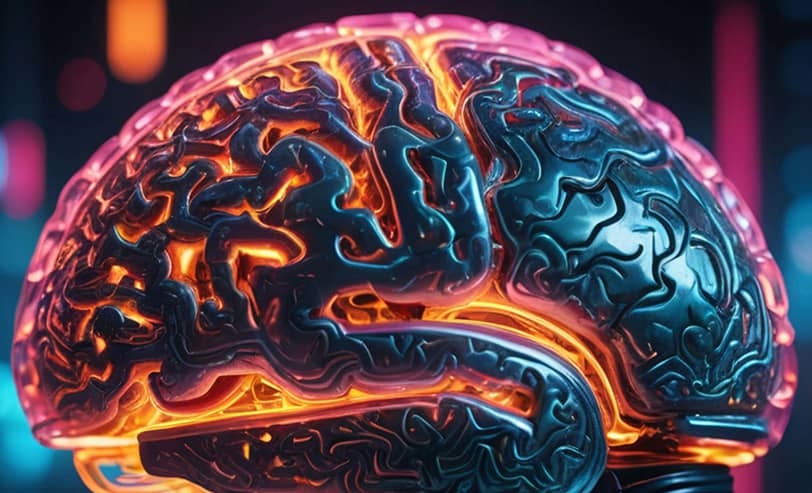
Conclusion
Neurobiology is transforming our understanding of human nature, revealing how thoughts, emotions, decisions, and even personality are shaped by billions of neurons and their interactions. Many brain processes once seemed mysterious and inexplicable, but today, science allows us to peek inside this incredible mechanism.
We are learning how the brain creates memories, why we feel joy or fear, and how it helps us adapt to changing conditions. This knowledge not only expands our horizons but also enables us to better understand ourselves, our actions, and our emotions.
The future of neurobiology promises even more groundbreaking discoveries. Scientists continue to explore phenomena such as neuroplasticity, which allows the brain to recover after injuries, and neurogenesis, which opens up possibilities for treating neurodegenerative diseases.
Technological advancements, including artificial intelligence and brain-computer interfaces, could revolutionize medicine, education, and even communication. For example, experiments are already underway to develop devices that enable people with disabilities to control technology using their thoughts. In the future, we may not only be able to treat brain diseases but also enhance cognitive abilities, improving memory, attention, and creativity.
But what does all this mean for each of us? How can we apply neurobiology knowledge today? The answer is simple: start small. Consider how you take care of your brain. Are you getting enough sleep? Eating properly? Giving your brain the opportunity to learn new things? These small steps can significantly improve your life.
For example, understanding how stress affects the brain may encourage you to practice meditation or breathing exercises. Recognizing the importance of sleep might lead you to adjust your schedule and prioritize rest. And knowing how the brain learns could inspire you to acquire new skills or study a foreign language.
Neurobiology not only opens new frontiers in science but also provides practical tools for improving quality of life. It reminds us that the brain is not a static organ but a dynamic system capable of change and development throughout life.
Use this knowledge to better understand yourself, take care of your health, and unlock your full potential. After all, the brain makes us who we are. And the more we know about it, the more opportunities we have to grow and thrive.
